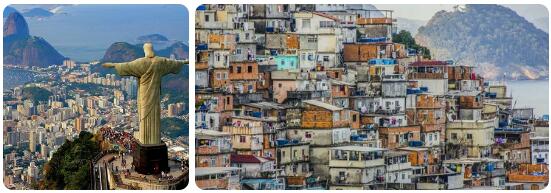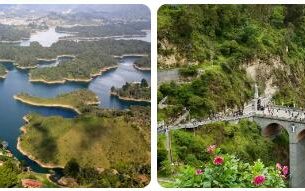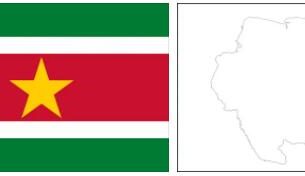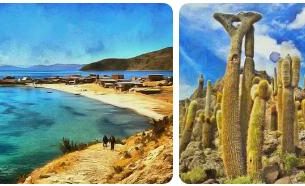Brazil – The fifth largest country in the world
Brazil is the fifth largest country in the world. The landscape is extremely varied.
You can find both wide beaches and deepest rainforest, especially in the Amazon region.
Brazilian football is one of the most successful in the world.
Brazil’s big cities like São Paulo and Rio de Janeiro or Brasilia are world metropolises.
However, one should not overlook the fact that there is widespread crime and corruption, as well as great wealth and extreme poverty in the country.
With over 17 million residents, São Paulo is the largest city in South America. Despite the immense size of the country, every fifth Brazilian lives in one of the big cities. Wide expanses of Amazonia or the marshland of the Pantanal in Mato Grosso and the Cerrado steppe are more or less uninhabitable, but offer a breathtaking variety of fauna and flora.
From June 12, 2014 to Jul 13, 2014, the country hosted the FIFA World Cup.
The opening match took place on June 12th at 17:00 local time (22:00 CEST) in Group A between Brazil and Croatia in the “Arena de São Paulo” in São Paulo. The game was won 3-1 by Brazil.
The final took place on July 13, 2014 at 4:00 p.m. local time at the Estádio do Maracanã in Rio de Janeiro between Germany and Argentina. Germany won the game 1-0 with a goal from Mario Götze and became world champions.
| Name of the country | Brazil |
| Form of government | Presidential Federal Republic |
| Geographical location | Brazil is located on the South American continentand borders the coast of the Atlantic Ocean. |
| National anthem | HINO NACIONAL DO BRASIL |
| Population | approx. 212 million (Credit: Countryaah: Brazil Population) |
| Ethnicities | European (54%), mestizo (34%), African minorities (11%)Japanese ancestry, Indian component (1%) |
| Religions | Roman Catholic and Evangelical Christianity |
| Languages | Portuguese |
| Capital | Brasilia |
| Surface | 8,547,404 km² |
| Highest mountain | Pico da Neblina 3,014 m |
| Longest river | Amazonas 6,577 km (3,615 km within Brazil) |
| Largest lake | Lagoa dos Patos (lagoon of the ducks) with 10,145 km² |
| National currency | Real (BRL), $ R |
| Time difference to CET | – 3 h to – 6 h (- means earlier than ours) |
| International phone code | 0055 |
| Internet TLD (Top Level Domain) | .br |
Brazil History
Until around the year 1000
Archaeologists have found signs of human life in the Rio de Janeiro region and dated up to 50,000 years ago in northeastern Brazil. It is believed to have existed between 60,000 and 8,000 BC. There were waves of immigration from Siberia, from which the indigenous people of Brazil emerged. However, the Brazilian Indians never developed a high culture like that of the Incas or Mayas, which is why little information about their culture exists. The population of the indigenous people of Brazil is estimated at the arrival of the Portuguese around 1500 at around 2 to 6 million who lived in around 1,000 different tribes. At this point in time, the tribes had a distinct cultural life in which music, dance and play played an important role. Frequent wars between the tribes and ritual cannibalism are also archaeologically documented.
Colonization period
According to Abbreviationfinder website, already in 1494, before the actual discovery of Brazil, was by an arbitration ruling Pope Alexander VI. in the Treaty of Tordesillas an agreement between Portugal and Spain on the division of the colonial territories was reached. A dividing line was drawn along the 48th parallel west longitude. Accordingly, almost all of Brazil belonged to the colonial territory of the Portuguese.
In 1500 the Portuguese navigator Cabral landed near Porto Seguro on the Brazilian coast and took possession of the area for Portugal. The French also tried to colonize the country in the following years, but were prevented from doing so by the Portuguese. In 1534 the Portuguese crown sent a fleet under the command of Alfonso de Souza, who was supposed to drive out the French and take the first steps towards colonizing the country. In 1534, the Portuguese King João III. the land in fifteen zones, the so-called Capitanías and gave them as inheritance to nobles and people from the middle class. Since this action did not produce the desired effect, namely to keep the costs of colonization low, in 1549 Tomé de Sousa was appointed the first governor general of the country.
The colonizers mainly continued to grow sugar cane. The indigenous people were forced to work on the plantations as slaves. However, since they frequently committed suicide or died from diseases imported from Europe, the Portuguese began to let African slaves work for them. By 1600 Brazil was the largest sugar producer in the world.
The exploitation of the colonies aroused the desires of other nations that had not benefited from the Treaty of Tordesillas. In 1555-67 the French established a small colony near Rio de Janeiro. They were able to establish themselves in Paraiba in 1596 and in Maranhão in 1612-1615. In 1624 the Dutch dared to attack the country’s capital and occupied part of the north coast between 1630-1654. This led to uncertainty among the plantain owners, who as a result gave up their lands. Numerous slaves used this opportunity to flee and founded their own settlements. The Portuguese did not tolerate their existence and destroyed the last one in 1669.
While sugar cane cultivation, carried out with African slaves, flourished in the coastal area, the so-called Bandeirantes (adventurers) penetrated from São Paulo to the foothills of the Andes in search of gold, diamonds and Indian slaves, thus continuously expanding the Portuguese sphere of influence. Gold discoveries at Minas Gerais in 1695 triggered a real mass influx of gold prospectors. Since the sugar trade was in a crisis at that time, gold became an important part of the export trade. Accordingly, in 1773 Rio de Janeiro was declared the new capital of the country, as it was closer to the gold deposits.
At the end of the 18th century there were increased uprisings in the country against the Portuguese colonial power. The most important uprising was the “Inconfidência Mineira” in the gold mining region of Minas Gerais. A conspiracy was formed there, to which the rich of the region in particular belong. The aim of the “Inconfidencia Mineira” was to achieve independence and abolish slavery, following the example of the USA. After the group’s betrayal in April 1792, their leader Joaquim José da Silva Xavier (called Tiradentes) was the only one of the conspirators to be executed in Rio de Janeiro.
independence
Since his homeland Portugal was threatened by Napoleonic troops, Prince Regent João (later João VI) fled to Brazil in 1807 and declared Rio de Janeiro to be the capital of the United Kingdom of Portugal in 1808. With him he not only carried the state treasury of the country but also his entire court, which brought the city a considerable increase in population.
The territorial reorganization of Europe in the course of the Congress of Vienna in 1815 also had an impact on the status of Brazil. The country was formally equated with the mother country within the framework of a “United Kingdom of Portugal, Brazil and Algarve” and thus became a separate kingdom. After João VI. Returned to Portugal in 1821, his son Pedro declared the country’s independence a year later on September 7, 1822 and was crowned emperor on December 1, 1822.
This was preceded by the attempt of the Portuguese Cortes to turn back time and demote Brazil to a colony. The regent Dom Pedro justified with the exclamation “Independência ou morte!” (Independence or death) the independence of Brazil. In the years that followed, Brazil was recognized by many countries, including Portugal.
First Empire (1822-1831)
The achievement of independence distinguishes Brazil from all other countries in Latin America. In Bolivia and Ecuador, the colonizers were only abducted by military resistance under the leadership of Simon Bolívar. Said countries later became republics. Brazil, on the other hand, became a constitutional monarchy with a liberal constitution in 1824. In 1825, Uruguay split from Brazil.
The politics of Pedro I aroused popular resistance. In addition, Pedro’s political interest was directed primarily towards his home country Portugal. As a result, he succeeded his father João VI in 1831. and abdicated in favor of his son, who as Pedro II took over the affairs of state after he came of age in 1840.
Rainy season (1831-1840)
Parliament set up a provisional Regency Council, which was to lead state affairs until Pedro came of age.
Between 1835-1845 both the uprising of the “Cabanagen” (named after the “cabanos”, the poor dwellings of the residents) and the “Farrapen Revolution” (farrapos = rags) threatened the country’s political unity. The “Cabanagem” in the province of Belém and large parts of Pará declared themselves independent until the regent Pedro came of age. The cattle farmers in the province of Rio Grande do Sul, however, feared for their economic existence and therefore demanded protective tariffs for imports from Argentina and Uruguay. This led to a conflict with the government. In the meantime the Republic of Rio Grande do Sul was proclaimed. After the Italian Republican Giuseppe Garibaldi joined the movement, a daughter republic could be proclaimed in the neighboring province of Santa Catarina. Unlike the “Cabanagen” uprising, the “Farrapen Revolution” was an uprising of the country’s upper class. Therefore, the government shied away from taking tough action. In the agreement reached in 1845, the government made numerous concessions to the rebels.
Second Empire (1840-1889)
In 1840 Pedro II took over the official business. Together with Argentina and Uruguay, Brazil waged war against Paraguay between 1865-1870. Great Britain
already had in 1826Demanded from Brazil the abolition of the slave trade within a time frame of five years, which the Brazilian government followed in 1831. In fact, however, nobody adhered to it, because new black work slaves were constantly being demanded to expand the coffee, sugar and tobacco plantations. It was only through a law of 1850 that the slave trade was prevented. For economic reasons, the government did not seek a radical solution. A law of 1871 declared the children of slaves free, which meant that slavery was only gradually done away with. In 1885 all slaves over sixty years of age were declared free. During the absence of Pedro II, the Infanta, Isabel, Pedro’s daughter, signed a law abolishing slavery in 1888 (called: Lei Aurea = the golden law). The previous pillars of the monarchy,
A year later, Pedro II was overthrown by the military in a coup. Manuel Deodoro da Fonseca then proclaimed the Republic of the United States of Brazil.
First Republic (1889-1930)
Deodoro was the country’s president from 1889-1891. The constitution of the new republic was based heavily on the federal model of the USA. Party struggles, situations similar to civil wars and the breakdown of finances, but also the first approaches to industrialization, developed in the economically stronger states, especially in the state of São Paulo.
Dictatorship (1930-1945)
High national debt and the overproduction of coffee combined with its price drop in the wake of the global economic crisis led to the economic collapse of Brazil. Getúlio Vargas came to power at the head of an insurrectionary movement. He ruled the country twice as dictator (1930-1934 and 1937-45) and twice as elected president (1934-37 and 1951-54). With the help of the constitutions of 1934 and 1937 (establishment of the “Estado Novo”: authoritarian system of government on a cooperative basis) he developed a personal dictatorship. Parties were banned in 1937. The October 1945 revolution forced Vargas to resign and Brazil became a democratic republic again.
Second Republic (1945-1964)
Vargas was re-elected president in 1950 and tried again to pursue an authoritarian domestic policy. After being forced to resign by the military, he committed suicide. The President Juscelino Kubitschek drove the internal expansion of Brazil, especially the industrialization and the construction of the new capital Brasilia (since 1960) with great energy. However, its expansion program overloaded the state budget.
Military rule (1964-1985)
With the overthrow of the social reformist President Goulart (including expropriation of lands in favor of landless farmers) in 1964, a 21-year military rule began: important constitutional guarantees were suspended and human rights violations occurred. In 1983/84 there were nationwide rallies for direct presidential elections (“diretas já”).
Democracy (1985-present)
The restoration of democracy takes place in 1985. And in 1988 a democratic constitution was passed. With the introduction of the real as the new currency, inflation was brought under control; former finance minister Fernando Henrique Cardoso was elected president and ruled for two terms. In the local elections in 2000, the PT Workers’ Party emerged as the main winner. On January 1, 2003, President Luiz Inácio Lula da Silva took office. Silva won the presidential election in the second round on October 27, 2002 against his rival José Serra from the Brazilian Social Democratic Party (PSDB). He succeeded Fernando Henrique Cardoso in office, who had been the President of Brazil since 1995. In the presidential election on October 3 and the subsequent run-off on December 31, In October 2010 Dilma Rousseff (born 1947) – da Silva’s political foster daughter – was elected President. She is the first woman to head the country. Rousseff is the daughter of an immigrant Bulgarian intellectual and businessman and spent three years in prison during the military dictatorship (1964-1985). She took office on January 1, 2011 when she was sworn in.



